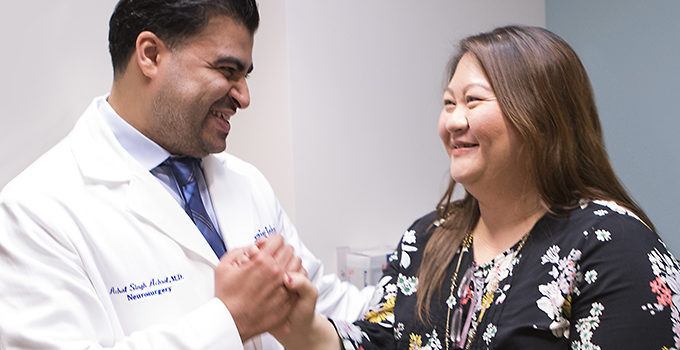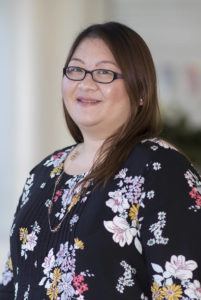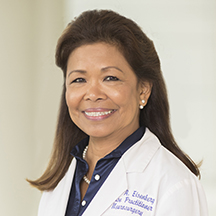

PATIENT STORY: A Moyamoya Experience
by Zara Jethani
A month before her birthday in December 2016, Joanna, a young energetic wife and mother living in Guam, experienced the onset of unusual stroke-like symptoms, including numbness and weakness in her arm and leg. She was unable to continue working and after visiting her doctor, she was diagnosed with Moyamoya disease.
https://youtu.be/7v-JQN6O0gM
Moyamoya disease is a rare neurovascular condition that can affect both children and adults and is caused by progressive narrowing or blockage of the major blood vessels supplying the brain. The result is a lack of necessary blood flow to the brain, which can cause stroke, mini-stroke (TIA – transient ischemic attack) or bleeding into the brain. Numerous tiny vessels develop around the blockage in an attempt to compensate for the lowered blood flow, leading to a smoky appearance of these vessels on imaging. This smoky appearance is what gives the disease its name, as “moyamoya” means puff of smoke in Japanese.

“Although a high number of cases of Moyamoya disease are found in people of Asian descent, it has now been recognized worldwide across all ethnic groups,” says Achal Singh Achrol, MD, Director of Neurovascular Surgery and Neurocritical Care at the Pacific Neuroscience Institute (PNI) at Providence Saint John’s Health Center. “Moyamoya disease should be a considered diagnosis in any patient experiencing unexplained transient neurologic episodes or strokes at a young age.”
Prior to joining PNI, Dr. Achrol was a lead investigator in Moyamoya disease research at Stanford University. Historically, the 5-year stroke risk in Moyamoya patients treated with medication-only was described starting at 40%, and up to 82% in patients like Joanna with bilateral disease and stroke presentation. In 2009, Dr. Achrol worked under the mentorship of Dr. Gary Steinberg to co-author the publication of Stanford’s clinical experience with 450 revascularization procedures for Moyamoya disease. In this study, the 5-year stroke risk after surgical revascularization was found to be effectively reduced to only 5.5% (as opposed to the 40 to 82% risk previously described with medication-only treatment).
For this reason, neurosurgical evaluation by an expert in the treatment of Moyamoya disease is the most important first step after diagnosis. In Joanna’s case, she traveled over 6,000 miles from Guam to Santa Monica, California after being referred to Dr. Achrol based on his neurovascular surgery experience and his particular expertise with the treatment of Moyamoya disease.

“From the beginning I felt like I was in good hands,” says Joanna. “I was constantly reassured that everything would be okay. This kept my spirits high even though I was terrified of what was about to happen. I entrusted that Dr. Achrol had chosen a great team to help me win this battle. Everyone was great to me and my family and they all helped me keep a smile on my face.”
“Joanna had disease affecting blood flow to both sides of her brain, as is often the case with Moyamoya disease,” explained Dr. Achrol. “In addition to her transient ischemic episodes of weakness, her MRI showed evidence of recent strokes, which made her case higher risk.”
Dr. Achrol performed the revascularization surgery on the right side of Joanna’s brain first. Called an extracranial-to-intracranial (EC-IC) bypass, the surgery creates new healthy pathways for normal blood flow to reach the brain. The first surgery was successfully completed in time for Joanna’s birthday and she was able to return home within 2 days of surgery. This was followed up by the same procedure on the left side three weeks later.
With both of her surgeries now behind her, Joanna is cleared to return home to Guam. “After surgery I was amazed at how low my pain was, given that it was in my brain,” she says.
“This disease is so rare there are very few neurovascular specialists,” says Dr. Achrol. “We were very fortunate that Joanna’s doctors in Guam referred her to get the care she needed. At Pacific Stroke & Aneurysm Center we are happy to offer our expertise regardless of where the patient is located. In fact, we routinely consult with international patients from other countries including China, Singapore and India.”
Joanna has had no recurrent TIAs or strokes since her procedures and is doing very well overall. She is currently back to all her normal routines, and says, “I left my health and wellbeing in the hands of our Lord and allowed Him to take control of the process. I thank God Almighty for Dr. Achrol, his team and Providence Saint John’s Health Center for helping me fight my fight with Moyamoya disease. God is good!”

Zara Jethani, MS, MBA, is the marketing director for the Pacific Neuroscience Institute. Her background is in graphic design, molecular genetics research and healthcare marketing.

Amy Eisenberg, MSN, ARNC, CNRN is the program nurse practitioner and clinical fellowship director at the Pacific Brain Tumor Center at Providence Saint John’s Health Center. Her clinical responsibilities support the efforts of the neurosurgery and neuroscience teams. In addition, she coordinates the Clinical Fellowship Program and the Neuroscience Nursing Symposium.
About the Author

Zara Jethani
Zara is the marketing director at Pacific Neuroscience Institute. Her background is in molecular genetics research and healthcare marketing. In addition, she is a graphic designer with more than 20 years experience in the healthcare, education and entertainment industries.
Last updated: February 16th, 2022